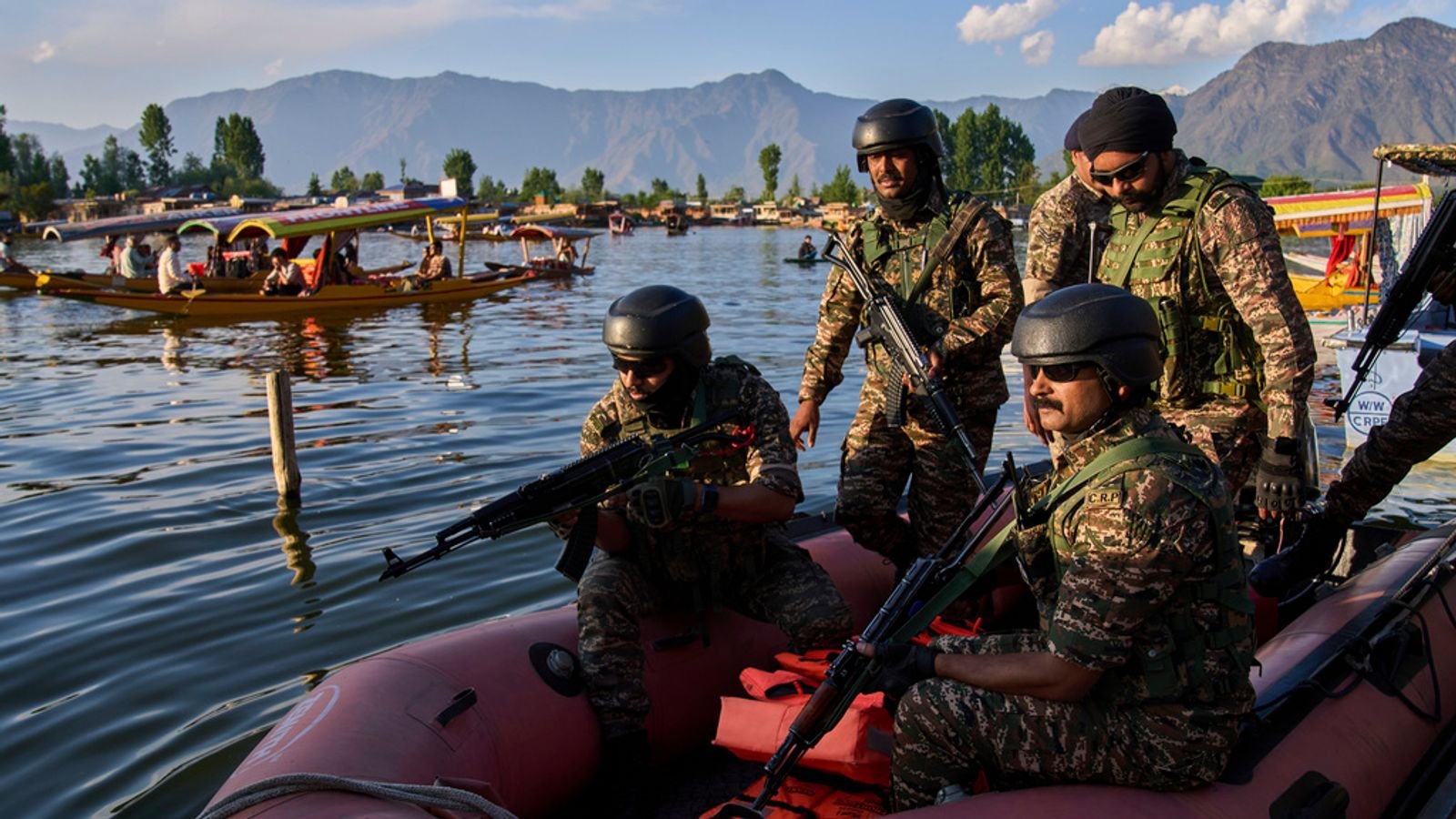Tensions between India and Pakistan have ramped up following a militant gun attack in the disputed area of Kashmir.
At least 26 people, most of whom were Indian tourists, were shot dead by gunmen at a beauty spot near the resort town of Pahalgam in the Indian-controlled part of the region on 22 April.
India described the massacre as a “terror attack” and said it had “cross border” links, blaming Pakistan for backing it.

Pakistan denied any connection to the atrocity, which was claimed by a previously unknown militant group called the Kashmir Resistance.
Since the attack, Pakistan’s military has been on high alert after a cabinet minister said Islamabad had credible intelligence indicating that India could attack.
Here is everything you need to know.
What happened during the attack?
In one of the worst attacks in recent times in Kashmir, which is split between the two countries, at least four gunmen fired at dozens of tourists who were enjoying their holidays in Baisaran meadow, which is three miles (5km) from Pahalgam, and known as ‘mini Switzerland’.
At least 26 people were killed, and three dozen others were injured, according to police officers.
Please use Chrome browser for a more accessible video player
Security forces have detained around 500 people for questioning after they searched nearly 1,000 houses and forests in Indian Kashmir, a local police official told the Reuters news agency.
At least nine houses have been completely demolished, a common anti-militancy tactic in Kashmir.
India’s defence forces have also conducted several military exercises across the country since the attack. Some of these are routine preparedness drills, a defence official said.


Funerals for several of those killed have already been held in some Indian cities, and people took part in candle-lit vigils at several places, including in Srinagar, the biggest city in Indian-administered Jammu and Kashmir, in the disputed region.
Locals shut down markets, businesses and schools the day after the attack in protest, amid worries that it would hurt the region’s tourism economy.

What is the Kashmir Resistance?
The Kashmir Resistance, also known as The Resistance Front, claimed responsibility for the attack.
The group, which emerged in 2019, is considered a splinter group of the Pakistan-based Lashkar-e-Taiba (LeT), according to the South Asia Terrorism Portal, a Delhi-based thinktank.
LeT is listed as a terrorist organisation by the US. The same group was accused of killing 166 people during a four-day attack on Mumbai in 2008.
At the time, the group was alleged to have close ties to Pakistan’s spy agency, the Inter-Service Intelligence – an accusation Islamabad denied.

Ajai Sahni, head of the South Asia Terrorism Portal, told Reuters that groups like these have been created by Pakistan as a way of creating a “pattern of denial that they were involved in terrorism in Jammu and Kashmir”.
Pakistan has always denied that it supports and funds militants in Kashmir, saying it offers only moral and diplomatic support.
How have India and Pakistan reacted?
India’s Prime Minister Narendra Modi, who cut short his visit to Saudi Arabia and returned to India, “strongly” condemned the attack.
Addressing a rally in the eastern Indian state of Bihar on 24 April, he said his government will “identify, track and punish every terrorist and their backers”.
“We will pursue them to the ends of the earth,” he said, adding: “Terrorism will not go unpunished. Every effort will be made to ensure that justice is done.”
Please use Chrome browser for a more accessible video player
Speaking to Sky News’ The World With Yalda Hakim, Pakistan’s defence minister Khawaja Asif said that the attack could lead to an “all-out war” between his country and India and that the world should be “worried”.
Mr Asif denied his country was involved but instead suggested India had “staged” the shooting in a “false flag” operation. He warned his military was “prepared for any eventuality” amid escalating tensions and diplomatic measures from both sides.
“We will measure our response to whatever is initiated by India. It would be a measured response,” he said.
Indi and Pakistan have also announced reciprocal measures against each other, including revoking visas issued to nationals of either country, suspending trade, expelling military advisers, closing airspace and border crossings.
Please use Chrome browser for a more accessible video player
India has also suspended a crucial water-sharing treaty known as the Indus Water Treaty – a move Pakistan’s prime minister Shehbaz Sharif warned would be considered an act of war.
The treaty, which was brokered by the World Bank in 1960, is essential for supporting agriculture and hydropower for Pakistan’s 240 million people. Suspending it could lead to water shortages at a time when parts of the country are already struggling with drought and declining rainfall.
So far, New Delhi has ignored the threats and made moves that have already put pressure on water supplies to Pakistan. This includes running maintenance work to raise the capacity of two operational hydroelectric plants in the Indian-controlled Jammu and Kashmir.


‘Credible intelligence’ of pending military action
In a statement on 30 April, Pakistan said it had “credible intelligence” that India intends to carry out military action against it in the “next 24-36 hours on the pretext of baseless and concocted allegations of involvement in the Pahalgam incident”.
The claims followed the Indian army saying it had responded to “unprovoked” small arms fire from Pakistan army posts on a number of occasions.
Pakistan’s foreign minister Ishaq Dar said in televised remarks that Pakistan “will exercise full restraint, but if India takes any adventurous step, then we will give a befitting response”.

On 5 May, Pakistan’s military said it test-fired a short-range missile, the second such test launch after a medium-range missile a few days before.
The military said that the Fatah surface-to-surface missile has a range of 75 miles and was launched from an undisclosed location.
India’s foreign and defence ministries have not commented on the claims it is planning military action.
US secretary of State Marco Rubio and Russian foreign minister Sergey Lavrov are among a handful of foreign dignitaries who have spoken with Islamabad’s Mr Dar about the ongoing situation.

After a visit by Iran’s foreign minister Abbas Araghchi, Mr Dar said he welcomed mediation to defuse the tensions with India.
“We will not be the first to take any escalatory step,” he said at the beginning of May, adding that he had warned the international community that should there be “any act of aggression by India, Pakistan will resolutely defend its sovereignty and territorial integrity”.
The United Nations also urged both sides “to exercise maximum restraint and to ensure that the situation and the developments we’ve seen do not deteriorate any further”.
What’s behind the tension between the countries?
India and Pakistan have fought several wars and conflicts since their independence from Britain in 1947, primarily due to territorial disputes over Kashmir.
Both countries claim the Himalayan region as their own, but in reality control different sections of the territory.

Armed insurgents in Kashmir have resisted New Delhi for decades, with many Muslim people in the region supporting the rebels’ goal of uniting the territory either under Pakistan’s rule or as an independent country.
The dispute over the land has claimed the lives of tens of thousands of people over the past three decades, although outbreaks of sporadic violence did seem to have eased in recent years.
In 2019, a suicide bomber in a vehicle killed 40 paramilitary soldiers in a military convoy, which brought the two countries close to war.

Follow The World podcast
Listen to The World with Richard Engel and Yalda Hakim every Wednesday
Read more from Sky News:
A ‘barbaric’ 24 hours in the ‘horrendous’ Russia-Ukraine war
There are signs the world is losing faith in the dollar
Before that, there was the Mumbai terror attack in 2008 and in 1999, the 10-week-long Kargil War.
The conflict began after Pakistan’s military covertly occupied Indian posts across the line of control (LoC) in the Kargil region.
At least 1,000 combatants were killed on both sides. The fighting stopped after Pakistan asked then US president Bill Clinton to help de-escalate the conflict.
